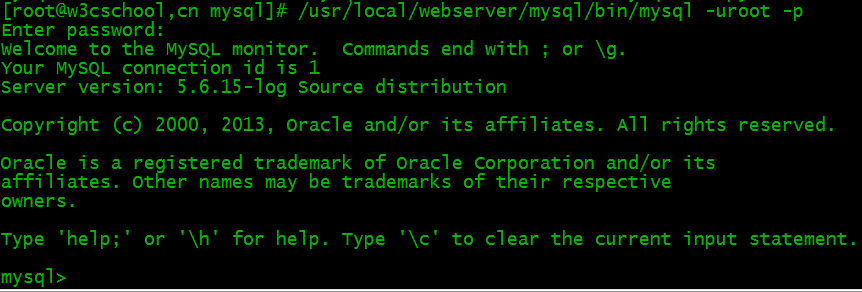MySQL installation configuration
May 22, 2021 Linux
Table of contents
MySQL is the most popular related database management system developed by MySQL AB of Sweden and currently owned by Oracle.
The SQL language used by MySQL is the most commonly used standardized language for accessing databases.
MySQL because of its small size, fast speed, low total cost of ownership, especially the characteristics of open source, the development of small and medium-sized websites generally choose MySQL as the site database.
MySQL installation
System platform for this tutorial: CentOS release 6.6 (Final) 64-bit.
First, install compilation tools and library files
yum -y install gcc gcc-c++ make autoconf libtool-ltdl-devel gd-devel freetype-devel libxml2-devel libjpeg-devel libpng-devel openssl-devel curl-devel bison patch unzip libmcrypt-devel libmhash-devel ncurses-devel sudo bzip2 flex libaio-devel
Second, install the cmake compiler
cmake version: cmake-3.1.1.
1, download address: http://www.cmake.org/files/v3.1/cmake-3.1.1.tar.gz
$ wget http://www.cmake.org/files/v3.1/cmake-3.1.1.tar.gz

2, unziw the installation package
$ tar zxvf cmake-3.1.1.tar.gz
3, into the installation package directory
$ cd cmake-3.1.1
4, compilation and installation
$ ./bootstrap $ make && make install
Third, install MySQL
MySQL version: mysql-5.6.15.
1, download address: http://dev.mysql.com/get/Downloads/MySQL-5.6/mysql-5.6.15.tar.gz
$ wget http://dev.mysql.com/get/Downloads/MySQL-5.6/mysql-5.6.15.tar.gz

2, unziw the installation package
$ tar zxvf mysql-5.6.15.tar.gz
3, into the installation package directory
$ cd mysql-5.6.15
4, compilation and installation
$ cmake -DCMAKE_INSTALL_PREFIX=/usr/local/webserver/mysql/ -DMYSQL_UNIX_ADDR=/tmp/mysql.sock -DDEFAULT_CHARSET=utf8 -DDEFAULT_COLLATION=utf8_general_ci -DWITH_EXTRA_CHARSETS=all -DWITH_MYISAM_STORAGE_ENGINE=1 -DWITH_INNOBASE_STORAGE_ENGINE=1 -DWITH_MEMORY_STORAGE_ENGINE=1 -DWITH_READLINE=1 -DWITH_INNODB_MEMCACHED=1 -DWITH_DEBUG=OFF -DWITH_ZLIB=bundled -DENABLED_LOCAL_INFILE=1 -DENABLED_PROFILING=ON -DMYSQL_MAINTAINER_MODE=OFF -DMYSQL_DATADIR=/usr/local/webserver/mysql/data -DMYSQL_TCP_PORT=3306 $ make && make install
5. View mysql version:
$ /usr/local/webserver/mysql/bin/mysql --version

At this end, the mysql installation is complete.
MySQL configuration
1, create mysql to run the user mysql:
$ /usr/sbin/groupadd mysql $ /usr/sbin/useradd -g mysql mysql
2. Create storage paths for binlogs and libraries and grant mysql user rights
$ mkdir -p /usr/local/webserver/mysql/binlog /www/data_mysql $ chown mysql.mysql /usr/local/webserver/mysql/binlog/ /www/data_mysql/
3, create my.cnf profile
Replace /etc/my.cnf with the following
$ cat /etc/my.cnf [client] port = 3306 socket = /tmp/mysql.sock [mysqld] replicate-ignore-db = mysql replicate-ignore-db = test replicate-ignore-db = information_schema user = mysql port = 3306 socket = /tmp/mysql.sock basedir = /usr/local/webserver/mysql datadir = /www/data_mysql log-error = /usr/local/webserver/mysql/mysql_error.log pid-file = /usr/local/webserver/mysql/mysql.pid open_files_limit = 65535 back_log = 600 max_connections = 5000 max_connect_errors = 1000 table_open_cache = 1024 external-locking = FALSE max_allowed_packet = 32M sort_buffer_size = 1M join_buffer_size = 1M thread_cache_size = 600 #thread_concurrency = 8 query_cache_size = 128M query_cache_limit = 2M query_cache_min_res_unit = 2k default-storage-engine = MyISAM default-tmp-storage-engine=MYISAM thread_stack = 192K transaction_isolation = READ-COMMITTED tmp_table_size = 128M max_heap_table_size = 128M log-slave-updates log-bin = /usr/local/webserver/mysql/binlog/binlog binlog-do-db=oa_fb binlog-ignore-db=mysql binlog_cache_size = 4M binlog_format = MIXED max_binlog_cache_size = 8M max_binlog_size = 1G relay-log-index = /usr/local/webserver/mysql/relaylog/relaylog relay-log-info-file = /usr/local/webserver/mysql/relaylog/relaylog relay-log = /usr/local/webserver/mysql/relaylog/relaylog expire_logs_days = 10 key_buffer_size = 256M read_buffer_size = 1M read_rnd_buffer_size = 16M bulk_insert_buffer_size = 64M myisam_sort_buffer_size = 128M myisam_max_sort_file_size = 10G myisam_repair_threads = 1 myisam_recover interactive_timeout = 120 wait_timeout = 120 skip-name-resolve #master-connect-retry = 10 slave-skip-errors = 1032,1062,126,1114,1146,1048,1396 #master-host = 192.168.1.2 #master-user = username #master-password = password #master-port = 3306 server-id = 1 loose-innodb-trx=0 loose-innodb-locks=0 loose-innodb-lock-waits=0 loose-innodb-cmp=0 loose-innodb-cmp-per-index=0 loose-innodb-cmp-per-index-reset=0 loose-innodb-cmp-reset=0 loose-innodb-cmpmem=0 loose-innodb-cmpmem-reset=0 loose-innodb-buffer-page=0 loose-innodb-buffer-page-lru=0 loose-innodb-buffer-pool-stats=0 loose-innodb-metrics=0 loose-innodb-ft-default-stopword=0 loose-innodb-ft-inserted=0 loose-innodb-ft-deleted=0 loose-innodb-ft-being-deleted=0 loose-innodb-ft-config=0 loose-innodb-ft-index-cache=0 loose-innodb-ft-index-table=0 loose-innodb-sys-tables=0 loose-innodb-sys-tablestats=0 loose-innodb-sys-indexes=0 loose-innodb-sys-columns=0 loose-innodb-sys-fields=0 loose-innodb-sys-foreign=0 loose-innodb-sys-foreign-cols=0 slow_query_log_file=/usr/local/webserver/mysql/mysql_slow.log long_query_time = 1 [mysqldump] quick max_allowed_packet = 32M
4, initialize the database
$/usr/local/webserver/mysql/scripts/mysql_install_db --defaults-file=/etc/my.cnf --user=mysql
The following information is displayed:
Installing MySQL system tables...2015-01-26 20:18:51 0 [Warning] TIMESTAMP with implicit DEFAULT value is deprecated. Please use --explicit_defaults_for_timestamp server option (see documentation for more details). OK Filling help tables...2015-01-26 20:18:57 0 [Warning] TIMESTAMP with implicit DEFAULT value is deprecated. Please use --explicit_defaults_for_timestamp server option (see documentation for more details). OK ...
5, create a boot start-up script
$ cd /usr/local/webserver/mysql/ $ cp support-files/mysql.server /etc/rc.d/init.d/mysqld $ chkconfig --add mysqld $ chkconfig --level 35 mysqld on
6, start mysql server
$ service mysqld start

7, connect MySQL
$ /usr/local/webserver/mysql/bin/mysql -u root -p

Modify the MySQL user password
mysqladmin -u用户名 -p旧密码 password 新密码
Or go to the mysql command line
SET PASSWORD FOR '用户名'@'主机' = PASSWORD(‘密码');
Create a new user and authorize:
grant all privileges on *.* to 用户名@'%' identified by '密码' with grant option;
Other commands
- Start: service mysqld start
- Stop: service mysqld stop
- Restart: service mysqld restart
- Overload configuration: service mysqld reload